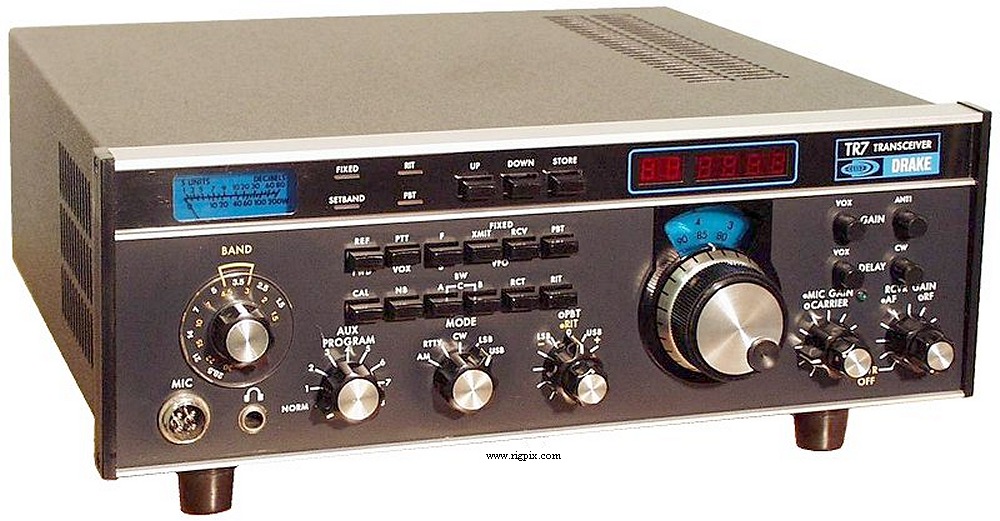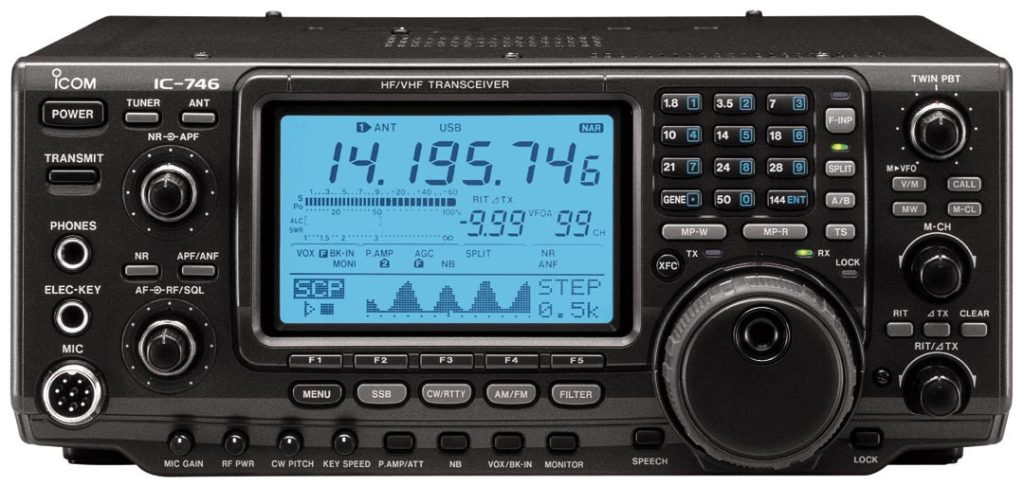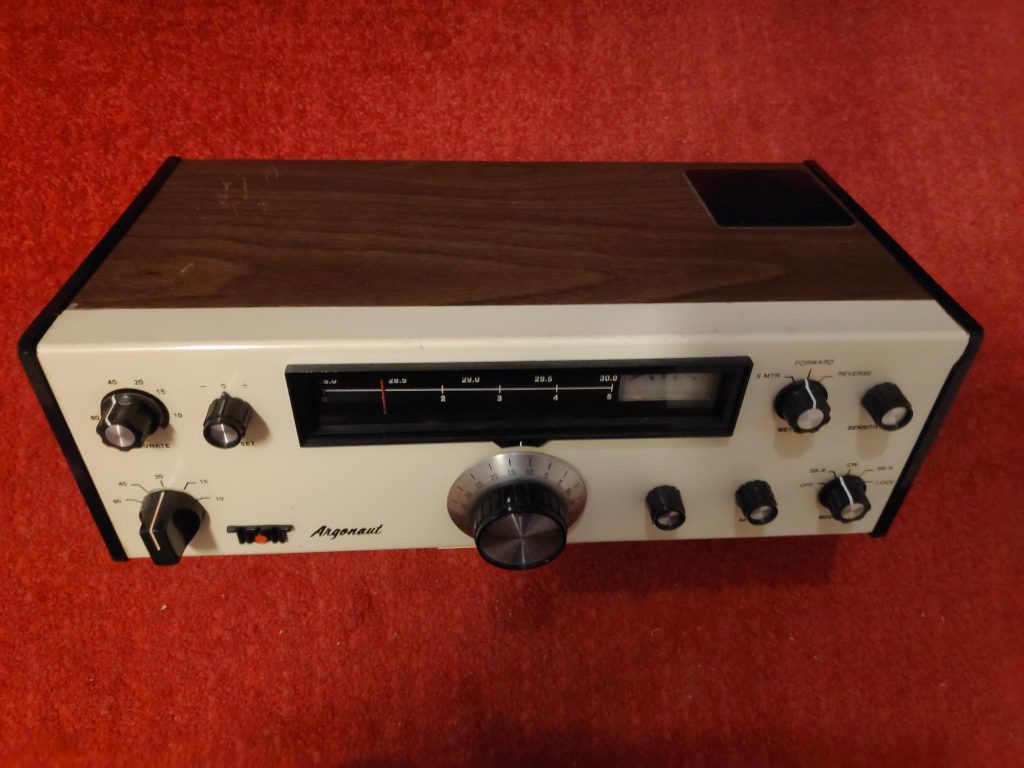In a weblog post titled Amateur Radio (2021-10-02), I confessed that I didn’t ever expect my radio equipment inventory to include a conventional amateur radio transceiver = sender and receiver.
Within a week of writing that, a radio that filled me with nostalgia was offered for sale, a Drake TR7. This is a 40 year old machine, that lacks many of the refinements/ finesses of a modern receiver. Unfortunately, it sold before I could purchase it. This was disappointing.

However, a more modern machine, an Icom IC-746, only about 20 years old, appeared in the same advertisement. It had a lot more refinements. Yet, it too was sold. This was actually a relief.

After a meeting of the Inntrøndelag/ Inner Trøndelag local group of the Norwegian Radio Relay League on 2021-10-21, I visited LB2KE (= a Norwegian amateur radio callsign) Svein Kåre Stubskin Tangen, leader of the local group. I ended up with a Ten-Tec (Tennessee Technology) Argonaut 505, with serial number 388, a transceiver from 1969 – 1973, a fifty year old machine, later paying NOK 350 for it. This machine belonged to LA8WG Jan Tverfjell, a silent key = deceased member of the group.

On Monday 2022-01-10, Alasdair and I visited Svein Kåre Stubskin Tangen again and came home with much more equipment originating with Jan Tverfjell, for NOK 500. This includes at least 2 x 2-meter band radios, an antenna matching unit = antenna tuner (AT), plus numerous small parts that may come in useful, at some time in the future. This equipment will be sorted and tested. Some of will be repaired, other pieces will be stripped into component parts.
I don’t need the 2-meter band radios, having one already, a gift from Alasdair. However, they can be useful in the recruitment of new amateur radio operators. I intend to give them away to people I know, and have encouraged to take their licence. I expect most of these will be women. In general, men have no inhibitions about buying hobby equipment for themselves. If one looks at the two genders, one finds very divergent purchasing patterns, in Norway and I suspect in Canada and USA! For example, I have managed to convince myself that I need 7 distinct types of electric saws to serve multiple use situations. These have all been purchased.

Patricia, my wife, manages to survive without any electric saws. In contrast, her knitting needle collection is large (easily exceeding 200). If I feel a need to knit, which I last felt working at Verdal prison in an attempt to break down stereotypic behaviour, I borrow needles from her. If she needs something cut with a saw, she typically enlists me to undertake the operation. With amateur radio, I expect that a lot of women would have difficulty justifying the purchase of a radio to themselves. It would be much easier for them to accept one as a gift.
I would like to encourage other radio amateurs to engage in similar behaviour, perhaps with a give it forward proviso. Radio recipients should be encouraged to give away equipment that is replaced, to someone new, without equipment. In other words, don’t give equipment back, give it forward. This concept can be traced back to Menander’s (c. 342/41 – c. 290 BC) play, Dyskolos = The Grouch, performed in Athens in 317 BC. Other people/ works expressing the concept include: Ralph Waldo Emerson (1803 – 1882), Compensation (1841), Lily Hardy Hammond (1859 – 1925), In the Garden of Delight (1916), and Robert Heinlein (1907 – 1988) Between Planets (1951). More recently Catherine Ryan Hyde (1955 – ) expressed it in her novel Pay It Forward (1999), which was made into the film of the same name in 2000, directed by Mimi Leder (1952 – ). There can be good reasons for keeping old equipment, including sentimentality. Thus, it is important that people do not allow themselves to be bullied into giving away/ selling equipment.
I am back to Plan A, the DIY/ homebrew/ home made rack-mounted HF = high frequency transceiver, that could provide different modulations, including SSB = single side band (a power-saving form of AM = amplitude modulation), FM = frequency modulation, and digital modes. VHF = very high frequency/ UHF = ultra high frequency are not being considered at the time. Nor is CW = continuous wave = Morse code .
Quaint fact: Amateur radio equipment has traditionally used 13.8 V as its standard voltage. In the circles I frequent, and to add to any confusion, this is pronounced, twelve volts.
As I prepared to write this post, my mind returned to the mid 1960s, and to the electronics classes I was taking. Making devices at that time was a much more complex undertaking, because electronic components were needed to implement many more different types of operations. Today, these can be programmed in software. Once a program is made, it can be used on countless other devices. This explains one reason for the popularity of not just software defined radio, but many other products.
The reasons for Plan A are relatively simple. However, there are general reasons, and personal reasons.
General Reasons
Until the beginning of the new millennium, most living rooms were only half social environments. The other half of the space was active storage. Music was stored on LP records or CD disks. Playing that music involved a number of devices: a turntable, an amplifier and at least two speakers. There were also books that were stored in a paper format on shelves. A television brought a signal into the living room. After a few decades, assorted recorders and playback machines allowed viewers to record programs, and to save them for later viewing, on VHS/ Betamax cassettes, then DVDs. Photography involved a camera, film, processing, slides/ negatives/ prints (depending on film type), photo albums/ slide storage containers, slide projector and screen, with extra bulbs.
Today, music, books and other forms of literature, audio-visual products including documentaries, television episodes and movies, and photographs can all be stored on and transferred to a variety of devices, included servers/ handheld devices such as phones and tablets/ laptops/ desktops/ wallframes. The last one is a new name for a screen that used to be called a television, that can be used to display static images, when not being used to show moving pictures! Life is so much simpler, with less hardware. Apart from professionals, everyone else takes photos with their favourite hand-held device.
As in these other areas of life, radios too are becoming less hardware and more software. The challenge comes with the educational opportunities of radio operators. In North America, until about 1970, there was a strict sexist divide, that required boys to undertake industrial arts: woodworking, metalworking, electronics and draughting. At the same time girls were prohibited from taking these subjects, but were offered home economics courses: cooking and textiles, that were unavailable to boys. Later, both genders were allowed to select from both sets of subjects. In addition, new subjects gradually emerged to supplement and to a certain degree replace, these older ones. These new subjects included automotive mechanics and computer science/ programming.
Personal Reasons
My most important personal reason is that my office occupies an area of less than 4 square meters. Even with an expansion consisting of a new 1 500 x 300 mm shelf populated with 3 Ikea Moppa, mini-storage chests, and a 320 x 300 x 140 mm Biltema assortment wallbox, there will not be an excessive amount of room for radio equipment.
Related to this is my approach to tools. While I still have a number of self-contained tools, such as multimeters, that operate independently of a computer, I prefer tools that share components. An oscilloscope provides a good example. It is an electronic test instrument that graphically displays waveforms. Even today, these instruments frequently have their own built-in displays. Yet, why should one invest in yet another display, when every desktop computer already has one. For a person with some vision issues, a large, adjustable display is a much better solution. In addition, using a computer to process data and to display graphics is one way to save money, that could be invested in a more precise instrument.
A Solution
Thus, I plan to build my own radio hardware including amplifier using commonly available electronic components and store it inside a rack located away from the office, in the basement, that houses our NAS server. This halves the distance from my desk to the antenna/ flagpole, but necessitates the use of remote access procedures to operate the radio. The rest of the radio will be made in software, and stored inside one or more computers.
Similarly, there is no need for physical dials and switches, when these can be implemented as part of a graphic user interface, that use a keyboard and pointing device, if not a touchscreen. Apart from reserves that should be kept on hand in case something breaks, there is no need for more than one microphone, or one headphone set.
Amateur radio can be an enjoyable hobby, but one should know what one wants to get from it, before starting. It can be an effective tool that can be used in emergency situations. Some people are interested in actually communicating with others. Many have little interest in people, but like to win competitions. Another group avoids people altogether and concentrates on building radios and other components.
Personally, I am more interested in the equipment than any communication. I am more interested in digital capabilities than voice, especially using QRP = low powered equipment. However, I also have an interest in experimental (audio-)visual communication, involving both still images and video, especially for use in emergency situations.
In terms of instruments, I have found that a Red Pitaya could act as my primary workbench tool. It saves workbench space by being able to perform multiple functions. It attaches directly onto a computer with screen that is already taking up workbench space.

Radios require antennas. There are many different types, some suitable for specific bands, but not others. These have to be built to match the type of activity envisioned. We are considering an HF antenna suitable for several bands, that can built into/ operate from our 8 m high fibreglass flagpole.
Warning: the remainder of this post is more technical. Some people may prefer to hop over the details of amateur radio communication.
The Ten-Tec Argonaut 505 transceiver is a pure QRP machine, with 5 W out, 13.8 V and 1.2 A in. Some work remains before it is ready to receive or to transmit. A microphone has to be adapted to fit the line input on the radio. There was no power supply unit (PSU) with the machine. Fortunately, I have a 0 – 30 V, 0 – 5 A linear PSU, that should do. Antenna components have been acquired, but are not yet in place.
19-inch racks: A 19-inch rack is a standardized frame or enclosure for mounting multiple electronic equipment modules. It was developed by the American Telephone & Telegraph Company in about 1922, making it 100 years old. Each module has a front panel that is 19 inches (482.6 mm) wide, including protruding edges/ ears on each side, that allow the module to be fastened to the rack frame with screws or bolts. The height of a rack is measured in Us, with 1U = 1.75 inches = 44. 45 mm high. A full height rack is 42 U tall. Such units typically occupies data centres, and corporate offices.
The rack in our basement is half-height = 21 U. The length of the unit is 800 mm. The top of the rack has been transformed into a desktop, which holds a computer screen, mouse and keyboard, plus an assortment of tools. The top of the rack/ desk is 1010 mm off the ground.
The rack currently has a lot of vacant real-estate, probably in excess of 10 U. Thus, new equipment could (theoretically) occupy 400 litres. I suspect that a radio should not occupy more than 2 U in height, or about 80 litres. In contrast, an Icom IC-746 occupies about 11 litres, and weighs about 9 kg. This means that using a rack there is no need for excessive miniaturization. A shelf 250 mm long has been fitted, but could be augmented or replaced with longer shelves if necessary.
There are two ways in which radio frequencies are described. The first is to use the frequency itself. There is a certain amount of imprecision used in amateur radio slang. high frequency (HF) is very specific both in terms of frequency (3 to 30 MHz) and wave length (100 to 10 m). However, a HF receiver will typically take in signals from 0.03 – 60 MHz, with wavelengths from 10 000 m to 5 m. A VHF receiver would take in frequencies 300 to 30 MHz, of which 144-148 MHz, covers the main amateur radio FM band. Signals in the VHF range have wavelengths of 10 to 1 meter
For radio transmission, specific bands are set off for different purposes, including amateur radio. Once again, the bands represent the wave lengths: 160 m = 1.800 – 1.999 MHz (technically, this is MF = medium frequency but is often clumped together with the HF bands); 80 m = 3.500 – 3.999 MHz; 40 m = 7.000 – 7.300 MHz; 30 m = 10.100 – 10.150 MHz, a popular HF band; 20 m = 14.000 – 14.350 MHz, another popular HF bands; 17 m = 18.068 – 18.168 MHz; 15 m = 21.000 – 21.450 MHz; 12 m = 24.890 – 24.990 MHz; 10 m = 28.000 – 29.700 MHz; 6 m = 50.000 – 54.000 MHz (Wavelengths between 10 and 1 m are in the VHF = very high frequency range); 2 m = 144.000 – 148.000 MHz (One of the main FM transmission bands).
Some of the bands are more important than others. For DX = typically, intercontinental communication, one would want to use bands with longer band widths, possibly 40 m. Shorter wave lengths are useful for more local communication.
Alasdair, my son, owns a Red Pitaya with a transceiver. It is often described as a Swiss army knife for engineers. It can replace many different instruments including: oscilloscope, to visualize wave forms; LCR meter, for measuring the characteristics of passive electrical components: R = resistance, C = capacitance, L = inductance and Z = impedance, and many more; spectrum analyzer, that measures the quality of signals; logic analyzer, for digital signals; Bode analyzer, that measures frequency responses in electronic circuits; and, a Vector Network Analyzer, used to test and optimize the performance of radio frequency components, such as antennas and cables.
Disruptive changes are happening throughout the technical world. At the end of 2021-12 Canon Chairperson/ CEO Fujio Mitarai stated: “Canon’s [single-lens reflex =] SLR flagship model is known as the ‘EOS-1’ series, the first of which appeared in 1989. The latest model ‘EOS-1D X Mark III’ released in 2020 will be the last model in fact.” PetaPixel, a photography news website, then predicted that both Canon and Nikon would not invest in new digital SLR cameras, which are bulky, in part because of their use of mirrors, and are now focused on the mirrorless camera market. They said they would be surprising if either company released a new SLR model in the future.
Initially, the language used in pre-college computer science was Logo, a programming language specifically designed for teaching in 1967 by Wally Feurzeig (1927 – 2013), Seymour Papert (1928 – 2016) and Cynthia Solomon (1938 – ). Logo is from the Greek logos, meaning word or thought. It used turtle graphic commands to move a floor/ screen robot (turtle).
Squeak an object-oriented, class-based, and reflective programming language derived from Smalltalk-80, and released in 1996, and Scratch, a high-level, block-based programming language, first released in 2003, have largely replaced Logo. They are more sophisticated than Logo, but I am not convinced that they are any better at teaching programming concepts. In fact, their complexity makes them worse.
This means that older men may have more of a focus on electronics and the hardware aspects of radio, while younger people may be more focused on programming and the software aspects of radio. Thus, before computers became part of everyday life, electronics and the construction of radios, often from kits, was an acceptable hobby. The difference between electronics as a hobby in, say, 1980 and from 2010, is mainly in the use of microprocessors, or their less powerful microcontroller relatives, especially built onto boards. Since about 2010, the Arduino Uno board has been a major focus. However, the AVR chip used on it does not meet the requirements needed in an amateur radio system. The Raspberry Pi is a much better match. Some people also make receivers with Teensy microcontrollers.
While I am fond of unusual programming languages, especially for my own personal projects, using one is not always the best approach if a community of users is expected to work together. My prejudiced opinion is that currently there are only two families of languages that are suitable for a community building the software components of a radio. These are C (and its derivatives, including C++) and Python. People who do not already have a sizeable investment in C, developed in 1972 by Dennis Ritchie (1941 – 2011) at Bell Telephone laboratories, Murray Hill, New Jersey, are encouraged to use Python, developed by Guido van Rossum (1956 – ) in 1991, who was working at Centrum Wiskunde & Informatica (CWI) = the Dutch national research institute for mathematics and computer science, in Amsterdam.

